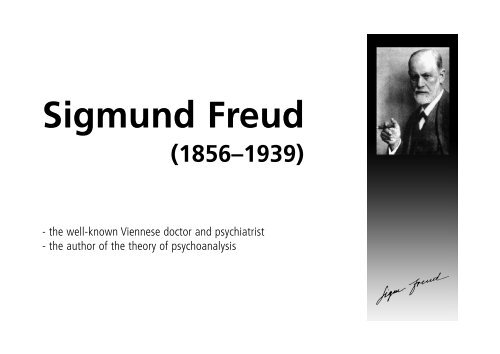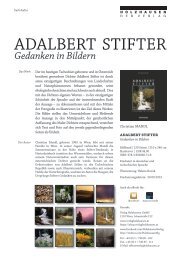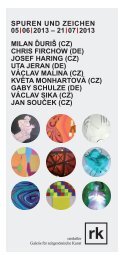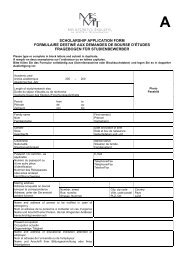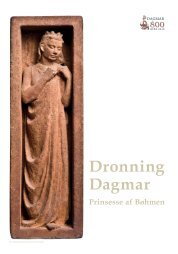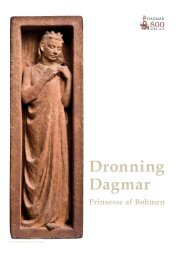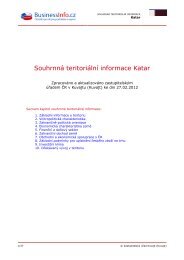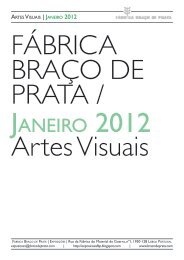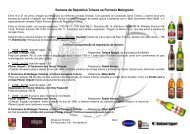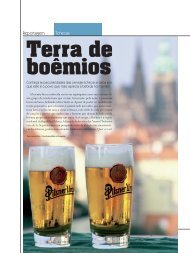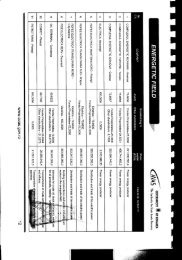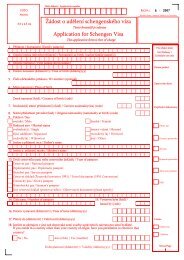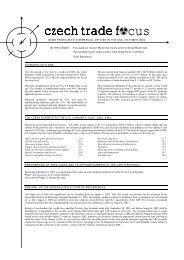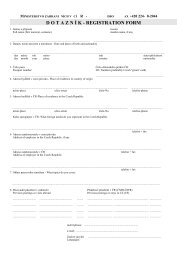You also want an ePaper? Increase the reach of your titles
YUMPU automatically turns print PDFs into web optimized ePapers that Google loves.
<strong>Sigmund</strong> <strong>Freud</strong><br />
(1856–1939)<br />
- the well-known Viennese doctor and psychiatrist<br />
- the author of the theory of psychoanalysis
Life in dates<br />
• born on 6 May 1856 in Pfiíbor (Freiberg), Moravia as Sigismund<br />
Schlomo <strong>Freud</strong> – he changed his name to <strong>Sigmund</strong> when<br />
he was 22 years old<br />
• his father, Kallmon Jacob <strong>Freud</strong>, was 20 years older than his<br />
mother, Amalia, née Nathanson; he had two sons from<br />
a previous marriage<br />
• <strong>Sigmund</strong> was the oldest of six children<br />
• at the end of 1859 and beginning of 1860, for economic<br />
reasons the family was forced to move first to Leipzig and<br />
shortly afterwards to Vienna, where <strong>Freud</strong> lived until 1938<br />
• in 1873, he completed his studies at grammar school<br />
(he completed elementary school and grammar school<br />
as one of the best pupils)
Life in dates<br />
• in the same year, he started studying medicine at the university<br />
in Vienna (he had originally considered studying law<br />
and pursuing a political career, but, influenced by Goethe’s<br />
Nature, he eventually opted for a scientific career and medicine)<br />
• he encountered anti-Semitism for the first time during<br />
his studies at the university<br />
• in 1876–1882, he worked at the laboratory of physiology<br />
of Ernst Brueck, who became a lifelong role model for him;<br />
here, <strong>Freud</strong> explored the histology of nerve cells<br />
• in 1881 he completed his medical studies<br />
• in the next year he met and became engaged to his future wife,<br />
Martha Bernays (1861–1951)
Life in dates<br />
• at the recommendation of his teacher, <strong>Freud</strong> terminated<br />
his research career because of ongoing financial problems,<br />
and began preparing to open his own private practice<br />
• in 1883–1885 he worked at the Vienna General Hospital<br />
to gain experience<br />
• in 1884, he discovered the analgesic effects of cocaine<br />
and began experimenting not only on himself, but also on<br />
his patients; he was named senior consultant at the Vienna<br />
General Hospital<br />
• in the following years (up to 1887), he published five works<br />
on the effects of cocaine<br />
• in 1885, he took a higher doctorate at Vienna University<br />
in neuropathology and was awarded a senior lectureship
Life in dates<br />
• in 1885, he went on a study trip to Paris, where he became<br />
acquainted with the work of Professor Jean-Martin Charcot;<br />
he attended his demonstrational interpretations of cases<br />
of hysteria and the effects of hypnosis and suggestion<br />
• in 1886 he opened a private practice; in addition to this,<br />
he worked as a neurologist in the Children’s Hospital Institute;<br />
in September he married Martha<br />
• besides electrotherapy, <strong>Freud</strong> used hypnosis to treat patients<br />
• in 1887, the <strong>Freud</strong>s have a daughter, Mathilda<br />
• in 1889, he visited Hippolyt Bernheim in Nancy to learn about<br />
his hypnosis techniques; in the same year his son Jean-Martin<br />
was born
Life in dates<br />
• in 1891, his son Olivier was born, followed in successive years<br />
by Ernst and Sophie<br />
• in 1894, <strong>Freud</strong> published a study on defensive psychoneuroses<br />
• in the next year, he published a study, with Breuer, on hysteria;<br />
a daughter, Anna, is born<br />
• in 1896, <strong>Freud</strong>’s lecture on the sexual aetiology of hysteria met<br />
with opposition and resistance among students<br />
• in 1897, <strong>Freud</strong> observes a breakdown of values in himself;<br />
he subsequently defines the Oedipus complex and explores<br />
the world of imagination<br />
• in 1899 he published Interpretation of Dreams (the book notes<br />
cite 1900 as the year of publication)
Life in dates<br />
• in 1902, <strong>Freud</strong> was appointed an Ausserordentlicher Professor;<br />
he surrounded himself with a group of students: Alfred Adler,<br />
Max Kahane, Rudolf Reitler, Wilhelm Stekel, Hugo Heller,<br />
Paul Federn, Max Graf, Eduard Hitschmann, etc.<br />
• in 1909 <strong>Freud</strong>, accompanied by his students Ferenczi and Jung,<br />
travelled to America, where he was invited to deliver a series<br />
of lectures at Clark University; his psychoanalysis gradually starts<br />
to become known and acknowledged around the world<br />
• at this time, he wrote his studies Analysis of a Phobia in<br />
a Five-Year-Old Boy and Notes Upon a Case of Obsessional<br />
Neurosis
Life in dates<br />
• in 1910, a psychoanalytical congress was held in Nurnberg,<br />
the International Psychoanalytical Association (IPV) was formed;<br />
<strong>Freud</strong>’s pupil and favourite Jung was appointed the president<br />
of the association; <strong>Freud</strong> publishes Five Lectures<br />
on Psychoanalysis<br />
• in 1916–17, he held a series of lectures entitled Introduction<br />
to Psychoanalysis<br />
• in 1918, he took part in the psychoanalytical congress<br />
in Budapest, where there was talk inter alia about the methods<br />
of treating war neurosis<br />
• in 1919, <strong>Freud</strong> wrote the paper Study of the Origin of Sexual<br />
Perversions<br />
• in 1921, he published Group Psychology and The Analysis<br />
of the Ego
Life in dates<br />
• in 1923, <strong>Freud</strong> was first diagnosed with cancer of the palate<br />
and underwent his first operation<br />
• in 1927, he published a work on fetishism and a work<br />
on religion (The Future of an Illusion)<br />
• in 1931, he addressed issues of female sexuality<br />
• in 1933, <strong>Freud</strong>’s books and the books of other Jewish writers<br />
and left-wing books were burned in Germany by<br />
the National Socialists<br />
• in 1938, Austria was annexed to Nazi Germany; <strong>Freud</strong>’s daughter<br />
Anna was interrogated by the Gestapo; the US President<br />
Roosevelt and Italian dictator Mussolini intervened with Hitler<br />
on <strong>Freud</strong>’s behalf, enabling him to emigrate from Austria
Life in dates<br />
• in June 1938, <strong>Freud</strong> and all his family travelled to London<br />
via Paris<br />
• on 23 September 1939, three weeks after the Second World<br />
War broke out, <strong>Sigmund</strong> <strong>Freud</strong> died at his home in London<br />
• all four of <strong>Freud</strong>’s sisters who had to remain in Vienna were<br />
deported to Terezín and Treblinka; none of them survived
The father of psychoanalysis<br />
• the basic idea of psychoanalysis is to find unconscious sexual<br />
causes for most mental problems<br />
• <strong>Freud</strong>’s theory and methods were initially considered<br />
as controversial and too revolutionary; they later became<br />
modern and accepted<br />
• modern science considers some of his hypotheses to be<br />
doubtful or obsolete; however, many of his views about mental<br />
disorders and treatment still apply today


